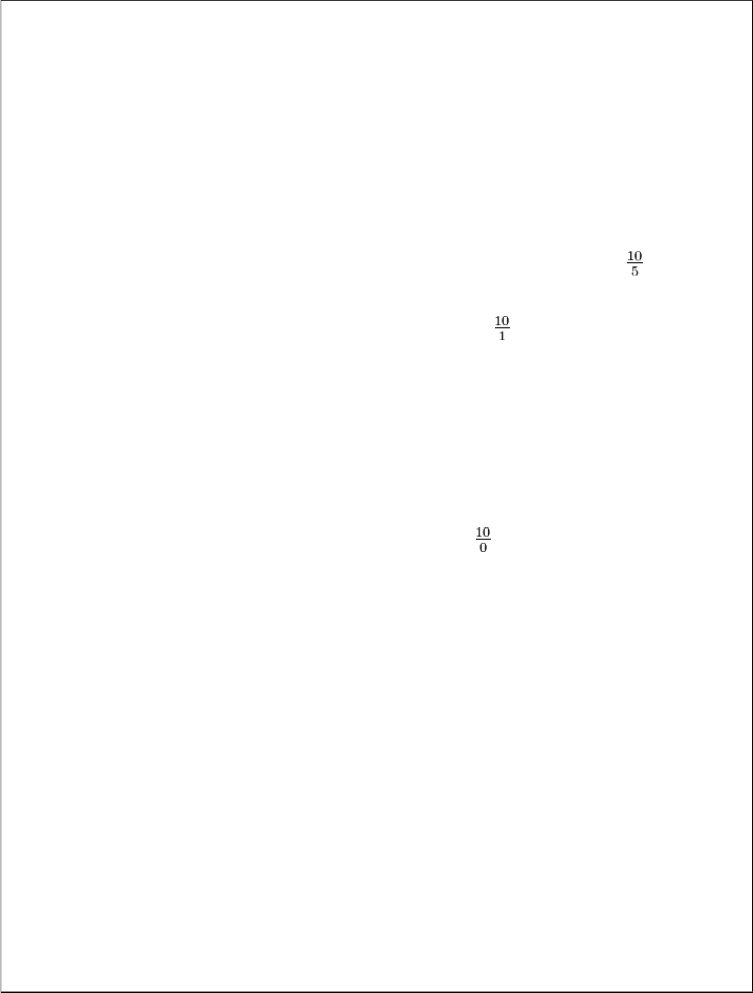
The research paper published by IJSER journal is about The Concept of Zero Continued… 1
ISSN 2229-5518

systems. In the English language, 0 may be called zero, nought or (US) naught (
/ˈnɔːt/), nil, or "o". Informal or slang terms for zero include zilch and zip. Ought or
aught ( /ˈɔːt/), have also been used.
number,[4] because it is divisible by 2. 0 is
neither positive nor negative. By some definitions 0 is also a natural number, and then the only natural number not to be positive. Zero is a number which quantifies a count or an amount of null size.
The value, or number, zero is not the same as the digit zero, used in numeral systems using positional notation. Successive positions of digits have higher weights, so inside a numeral the digit zero is used to
skip a position and give appropriate weights
to the preceding and following digits. A zero digit is not always necessary in a positional number system, for example, in the number
02. In some instances, a leading zero may be used to distinguish a number.
In the BC calendar era, the year 1 BC is the first year before AD 1; no room is reserved for a year zero. By contrast, in astronomical year numbering, the year 1 BC is numbered
0, the year 2 BC is numbered −1, and so on.
The oldest known text to use a decimal place-value system, including a zero, is the Jain text from India entitled the Lokavibhâga, dated 458 AD. This text uses Sanskrit numeral words for the digits, with words such as the Sanskrit word for void for zero.
The first known use of special glyphs for the decimal digits that includes the indubitable appearance of a symbol for the digit zero, a small circle, appears on a stone inscription found at the Chaturbhuja Temple at Gwalior in India, dated 876 AD. There are many documents on copper plates, with the same small o in them, dated back as far as
the sixth century AD, but their authenticity
may be doubted.
The value zero plays a special role for many physical quantities. For some quantities, the zero level is naturally distinguished from all other levels, whereas for others it is more or less arbitrarily chosen. For example, on the Kelvin temperature scale, zero is the coldest possible temperature (negative temperatures exist but are not actually colder), whereas on the Celsius scale, zero is arbitrarily defined
to be at the freezing point of water. Measuring sound intensity in decibels or phons, the zero level is arbitrarily set at a reference value—for example, at a value for the threshold of hearing. In physics, the
zero-point energy is the lowest possible
IJSER © 2012
Internatio nal Journal of Scientific & Engineering Research Vo lume 3, Issue 12, December-2012 2
ISSN 2229-5518
energy that a quantum mechanical physical system may possess and is the energy of the ground state ofthe system.
IJSER lb)2012
htiD:/ /'IVWW.iiser.org
The research paper published by IJSER journal is about The Concept of Zero Continued… 3
ISSN 2229-5518

The following are some basic (elementary) rules for dealing with the number 0. These rules apply for any real or complex number x, unless otherwise stated.
Addition: x + 0 = 0 + x = x. That is, 0 is an identity element (or neutral element) with respect to addition.
Subtraction: x − 0 = x and 0 − x = −x.
Multiplication: x · 0 = 0 · x = 0.
Division: 0⁄x = 0, for nonzero x. But
x⁄0 is undefined, because 0 has no multiplicative inverse (no real number
multiplied by 0 produces 1), a consequence of the previous rule; see division by zero.
Exponentiation: x0 = x/x = 1, except
that the case x = 0 may be left undefined
in some contexts; see Zero to the zero power. For all positive real x, 0x = 0.
The expression 0⁄0, which may be obtained in an attempt to determine the limit of an expression of the form f(x)⁄g(x) as a result of applying the lim operator independently to both operands of the fraction, is a so-called "indeterminate form". That does not simply mean that the limit sought is necessarily undefined; rather, it means that the limit of f(x)⁄g(x), if it exists, must be found by another method, such as l'Hôpital's rule.
Whether this expression can be assigned a well-defined value depends upon the mathematical setting. In ordinary (real number) arithmetic, the expression has no meaning, as there is no number which, multiplied by 0, gives a (a≠0). Historically, one of the earliest recorded references to the mathematical impossibility of assigning a value to a / 0 is contained in George Berkeley's criticism of infinitesimal calculus in The Analyst; see Ghosts of departed quantities.
In computer programming, an attempt to divide by zero may, depending on the programming language and the type of number being divided by zero, generate an exception, generate an error message, crash the program being executed, generate either positive or negative infinity, or could result in a special not-a-number value
Note:
The sum of 0 numbers is 0,
and the product of 0 numbers is 1.
The factorial 0! evaluates to 1.
In mathematics, division by zero is a term used if the divisor (denominator) is zero. Such a division can be formally expressed as a / 0 where a is the dividend (numerator).
IJSER © 2012
The research paper published by IJSER journal is about The Concept of Zero Continued… 4
ISSN 2229-5518

Zero! This term was coined in late century. Means nothing! No having the value as a count of zero.
We do have many critical deviations in calculations. Like divide by zero terms infinity. Multiply by zero is zero. And many more!
Let’s coin this point in the logical
frame. When we divide by a known zero
entity! Then its value is infinity. Logically we are doing what! Dividing it with a count of zero! Then it should be equivalent to the entity we are dividing, not infinity. And, when we are dividing it by 1. That means we are dividing the entity by 1.
If we consider the theory of fractions! Then, to divide an entity means to have that many equivalent parts of the entity. Like 10/1,
10/2, 10/3, 10/4, 10/5 ................. Thus, logically 10/0 means there is no entity. Like a destructor. But can the entity vanish just like that?
Let’s consider the case of multiply by zero. If you multiply by count zero then it should be zero.
This number zero and prime numbers and magic numbers like: 8 have some cool tips and tricks. Why these numbers are termed as magic numbers?
Nth root of entity is? Means to divide the entity by its nth times! And, if the entity is zero, then we are dividing it by its nth part logically. But since zero is the least part defined! Can’t break it further then it should be zero.
When division is explained at the elementary arithmetic level, it is often considered as a description of dividing a set of objects into equal parts. As an example, consider having ten apples, and these apples are to be distributed equally to five people at
a table. Each person would receive = 2 apples. Similarly, if there are 10 apples, and only one person at the table, that person
would receive = 10 apples.
So for dividing by zero – what is the number of apples that each person receives when 10 apples are evenly distributed amongst 0 people? Certain words can be pinpointed in the question to highlight the problem. The problem with this question is the "when". There is no way to distribute 10 apples amongst 0 people. In mathematical jargon, a set of 10 items cannot be partitioned into 0
subsets. So , at least in elementary arithmetic, is said to be either meaningless, or undefined.
Similar problems occur if one has 0 apples and 0 people, but this time the problem is in the phrase "the number". A partition is possible (of a set with 0 elements into 0 parts), but since the partition has 0 parts, vacuously every set in our partition has a given number of elements, be it 0, 2, 5, or
1000.
If there are, say, 5 apples and 2 people, the problem is in "evenly distribute". In any integer partition of a 5-set into 2 parts, one of the parts of the partition will have more elements than the other. But the problem with 5 apples and 2 people can be solved by cutting one apple in half. The problem with
5 apples and 0 people cannot be solved in
IJSER © 2012
The research paper published by IJSER journal is about The Concept of Zero Continued… 5
ISSN 2229-5518
any way that preserves the meaning of
"divides".
Another way of looking at division by zero, is that division can always be checked using multiplication. If x divided by y equals z, then z times y equals x. But if y is zero and x
is not zero, there is no such z. If y is zero and
x is also zero, then every z satisfies the multiplication problem.
Due to the above reasons that zero which has no meaning or have null value is not considered while building the Magic Matrices.
Symmetrical Matrixes: By n+1 rule:
[Each Row and Column and Diagonal
Count: 15] [Total Count: 65]
8 | 1 | 6 |
3 | 5 | 7 |
4 | 9 | 2 |
[Each Row and Column and Diagonal Count:
65] [Total Count: 455]
17 | 24 | 1 | 8 | 15 |
23 | 5 | 7 | 14 | 16 |
4 | 6 | 13 | 20 | 22 |
10 | 12 | 19 | 21 | 3 |
11 | 18 | 25 | 2 | 9 |
Similarly for 7*7, 11*11 etc…
Wikipedia
http://mathworld.wolfram.com/
IJSER © 2012